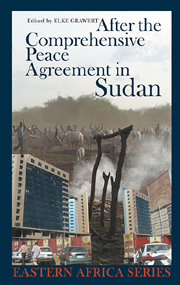Book contents
- Frontmatter
- Contents
- List of Tables & Figures
- Editor's Preface
- Notes on Contributors
- List of Acronyms
- Map of Sudan
- 1 Introduction
- I Implementation & Potential of the CPA
- II Challenges Facing Post-war Societies in Sudan
- III The CPA in its Sub-regional Context
- 11 Changes in Gambella, Ethiopia after the CPA
- 12 Ethiopian Federalism Seen from the Regional State of Gambella
- 13 From CPA to DPA
- 14 Challenges of Sub-regional Peace after the CPA
- IV Beyond the CPA
- Index
- EASTERN AFRICAN STUDIES
11 - Changes in Gambella, Ethiopia after the CPA
from III - The CPA in its Sub-regional Context
Published online by Cambridge University Press: 05 April 2013
- Frontmatter
- Contents
- List of Tables & Figures
- Editor's Preface
- Notes on Contributors
- List of Acronyms
- Map of Sudan
- 1 Introduction
- I Implementation & Potential of the CPA
- II Challenges Facing Post-war Societies in Sudan
- III The CPA in its Sub-regional Context
- 11 Changes in Gambella, Ethiopia after the CPA
- 12 Ethiopian Federalism Seen from the Regional State of Gambella
- 13 From CPA to DPA
- 14 Challenges of Sub-regional Peace after the CPA
- IV Beyond the CPA
- Index
- EASTERN AFRICAN STUDIES
Summary
Introduction
The Gambella region is located in south-western Ethiopia, bordering on Sudan at the Upper Nile and Jonglei States. The population of Gambella is currently estimated to be about 268,000. There are five ethno-linguistic groups usually defined as the indigenous people living in the region: the Nuer (40 per cent), the Anuak (27 per cent), the Majangir (6 per cent), the Opo and Komo (or Goma) (3 per cent). The 1902 Ethio-Sudan boundary delimitation divided the Nuer and the Anuak between both countries, putting more Anuak and fewer Nuer in the Gambella region of Ethiopia. The Nuer constitute the second largest people of the Nilotes in southern Sudan, whereas the majority of the Anuak live in the Gambella region.
These ethnic groups are marked by distinct cultural, linguistic and territorial communities as well as different livelihood strategies. The Anuak and the Opo are predominantly sedentary cultivators and the Nuer are agropastoralists, while the Majangir combine hunting, beekeeping, and gathering with shifting cultivation. The local population of Gambella also exhibit different modes of governance. In the Anuak traditional political system, there are two types of leaders, the Nyiya (kings), who used to control the south-west Anuak villages of Gambella, and the Kwaari (singular: Kwaaro) nobles, who controlled village states. The agro-pastoralist Nuer are led by headmen who are elected by each tribe. The Majangir, Komo and Opo are predominantly egalitarian with traditional socio-political organisations.
- Type
- Chapter
- Information
- After the Comprehensive Peace Agreement in Sudan , pp. 197 - 211Publisher: Boydell & BrewerPrint publication year: 2010

